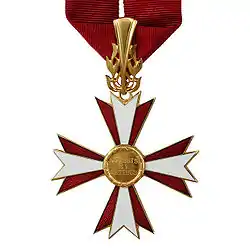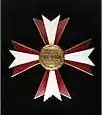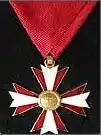Austrian Decoration for Science and Art
The Austrian Decoration for Science and Art (German: Österreichisches Ehrenzeichen für Wissenschaft und Kunst) is a state decoration of the Republic of Austria and forms part of the national honours system of that country.
| Austrian Decoration for Science and Art | |
|---|---|
 Badge of the Austrian Decoration of Honour for Science and Art | |
| Type | State decoration |
| Awarded for | "...superior creative and commendable services in the areas of the sciences or the arts."[1] |
| Presented by | |
| Eligibility | Austrian and foreign citizens[1] |
| Status | Currently Awarded |
| Established | 1955[1] |
Decoration for Science and Art Cross of Honour for Science and Art, First Class Cross of Honour for Science and Art | |
| Precedence | |
| Next (higher) | Varies by grade[1] |
| Next (lower) | Varies by grade[1] |
History
The "Austrian Decoration for Science and Art" was established by the National Council as an honour for scientific or artistic achievements by Federal Law of May 1955 (Federal Law Gazette No. 96/1955 as amended BGBl I No 128/2001). At the same time, the National Council also established the "Austrian Cross of Honour for Science and Art", which is awarded as "Cross of Honour, First Class" (German: Ehrenkreuz 1. Klasse) and "Cross of Honour" (German: Ehrenkreuz). While not technically counted as lower classes of the Decoration for Science and Art, these crosses are nevertheless affiliated with it.
Divisions
Decoration for Science and Art
The number of living recipients of the Decoration for Science and Art is limited to a maximum of 72 at any one time (36 recipients for science and 36 for arts). In each of these two groups there are 18 Austrian citizens and 18 foreign nationals.
Cross of Honour for Science and Art, First Class
There are no limits on the number of recipients.
Cross of Honour for Science and Art
There are no limits on the number of recipients.
Precedence
| Grade | Preceding | Following |
| Decoration for Science and Art | Grand Decoration of Honour in Silver with Star for Services to the Republic of Austria | Grand Decoration of Honour in Gold for Services to the Republic of Austria |
| Cross of Honour for Science and Art 1st Class | Military Merit Decoration | Grand Decoration of Honour for Services to the Republic of Austria |
| Cross of Honour for Science and Art | Grand Decoration of Honour for Services to the Republic of Austria | Decoration of Honour in Gold for Services to the Republic of Austria |
Recipients
Decoration for Science and Art
- 1957: Clemens Holzmeister, architect
- 1959: Max Mell, writer
- 1960: O. W. Fischer, actor
- 1961: Herbert von Karajan, conductor; Rudolf von Laun, international lawyer
- 1964: Edmund Hlawka, mathematician; Ernst Lothar, writer and director
- 1966: Ludwig von Ficker, writer and publisher
- 1967: Karl Heinrich Waggerl, writer; Lise Meitner, physicist
- 1969: Anny Felbermayer, soprano
- 1971: Fritz Wotruba, architect and artist
- 1972: Elias Canetti, writer
- 1974: Gottfried von Einem, composer
- 1975: Hans Tuppy, biochemist; Robert Stolz, composer
- 1976: Friedrich Torberg, writer and translator; Manfred Eigen, chemist
- 1977: Ernst Schönwiese, writer
- 1978: Hans Nowotny, chemist
- 1979: Roland Rainer, architect; Max Weiler, artist
- 1980: Alfred Uhl and Marcel Rubin, composer; Fritz Hochwälder, writer; Karl Popper, philosopher and science theorist
- 1981: Gertrud Fussenegger, writer; Werner Berg, painter
- 1982: Heinrich Harrer, mountaineer; Jacqueline de Romilly, philologist
- 1983: Hans Plank, painter
- 1985: Erika Mitterer, writer
- 1986: Johann Jascha, artist
- 1987: Friederike Mayröcker, writer
- 1988: Dietmar Grieser, author and journalist
- 1990: Ernst Jandl, writer; Hans Hollein, architect
- 1991: H.C. Artmann, writer
- 1992: Carlos Kleiber, conductor; Krzysztof Penderecki, composer
- 1993: Margarete Schütte-Lihotzky, architect; Peter Schuster, chemist; Gottfried Biegelmeier, physicist; Walter Thirring, physicist; Albert Eschenmoser, chemist; Albrecht Schöne, philologist; Günther Wilke, chemist
- 1994: Josef Mikl, painter; Erwin Chargaff, chemist
- 1995: Horst Stein, conductor
- 1996: Siegfried Josef Bauer, meteorologist and geophysicist
- 1997: Bruno Gironcoli, artist; Kurt Schwertsik, composer; Hans Hass, biologist; Robert Walter, jurist; Albrecht Dihle, classical philologist; Cassos Karageorghis, archaeologist; Klemens von Klemperer, historian
- 1998: Hans-Jörg Wiedl reptile expert Helmut Denk, pathologist
- 1999: Carl Pruscha, architect; Elisabeth Lichtenberger, geographer; Karl Acham, sociologist; Walter Kohn, physicist
- 2000: Paul Kirchhof, constitutional and tax lawyer; Hans Müllejans, provost; Herwig Wolfram, historian; Gerardo Broggini, lawyer
- 2001: Anton Zeilinger, experimental physicist
- 2002: Arik Brauer, painter, poet and singer; Peter Wolf, Austrian-born producer and composer; Eugen Biser, religious philosopher; Horst Dreier, legal philosopher; Elliott H. Lieb, physicist and mathematician; Bogdan Bogdanović, architect
- 2003: Hermann Fillitz, art historian; Wolfgang M. Schmidt, mathematician
- 2004: Klaus Wolff, dermatologist
- 2005: Václav Havel, writer, dissident and former president of the Czech Republic; Christian Attersee, painter; Eric Kandel, neuroscientist; Peter Palese, virologist
- 2006: Bruno Ganz, actor; Stephen Toulmin, philosopher; Christian Meier, historian; Pierre Soulages, painter; Michael Mitterauer, historian
- 2007: Otto Tausig, actor
- 2008: Marina Abramović, performance artist
- 2010: Paul Holdengräber, curator[2]
- 2012: Christoph Waltz, actor, director.
- 2013: Gerhard Rühm, author, composer, artist
- 2014: Abbas Kiarostami, film director, screenwriter, photographer
Cross (and Cross 1st Class)

- 1960: Karl Schiske, composer
- 1961: Günther Baszel, artist; Ernst Lothar, author and director
- 1965: Kurt Roger, Composer / Professor Georg Szell Conductor Nathan Milstein Violin
- 1967: Maria Augusta von Trapp, matriarch of the Trapp Family Singers
- 1968: Alphons Barb, author
- 1970: Enver Čolaković, writer and poet
- 1971: Gustav Zelibor, pianist and conductor
- 1974: Erika Mitterer, writer; Marcel Rubin, composer; Arthur Hilton, chemist,
- 1975 Karl Menger, mathematician
- 1976: Wolfgang Mayer König, writer
- 1977: Wolfgang Rehm, musicologist
- 1978: Kurt Neumüller, pianist and pedagogue
- 1980: Alfred Uhl, composer
- 1981: Thomas Christian David, conductor, composer, flutist

- 1983: Walter Bitterlich, forest scientist, Wolf Häfele, physicist
- 1984: Frank Sinatra, singer and actor, Fritz Muliar, actor and director, Ludwig Schwarzer, painter
- 1987: Alois Hergouth, writer and poet; Helen Adolf, literature scholar and linguist[3]
- 1989: Norbert Pawlicki, pianist and composer
- 1994: Christian M. Nebehay, art dealer and author
- 1996: Ronald S. Calinger, American historian of Mathematics; Fausto Cercignani, Italian scholar, essayist and poet; Quirino Principe, Italian philosopher of music and dramatist
- 1997: Herbert Willi, composer; Lucian O. Meysels, author; Ernest Manheim, American sociologist of Hungarian origin
- 1998: Senta Berger, actress, Kiki Kogelnik, artist (posthumously awarded), Edith Neumann, microbiologist.[4]
- 1999: Peter Simonischek, actor, Erich Gruen, historian.
- 2001: Klaus-Peter Sattler, composer, Hermann Maurer, computer scientist, Walter Homolka, rabbi; Hannspeter Winter, physicist; Johann Grander, inventor.
- 2002: Fabio Luisi, Italian conductor, Kurt Rudolf Fischer, philosopher, Wolfdietrich Schmied-Kowarzik, philosopher; John Ross, chemist; Seiji Ozawa, conductor
- 2003: Erich Schleyer, actor and author, Günther Granser, economist
- 2004: Oswald Oberhuber, artist, Hans Winter, veterinary pathologist
- 2005: Gottfried Kumpf, painter, architect, sculptor, Georg Ratzinger, choirmaster, Heinz Zemanek, computer pioneer
- 2006: Peter Ruzicka, German composer and artistic director, Lothar Bruckmeier, painter, Peter Wegner, computer scientist, Elisabeth Leonskaja, Russian pianist, Richard Kriesche, artist[5][6]
- 2007: Herbert W. Franke, scientist, writer, artist; Hans Walter Lack, botanist; Josef Burg, writer; Reginald Vospernik, high school director; Nuria Nono-Schönberg, Lawrence Schönberg, Ronald Schönberg, the three children of Arnold Schoenberg
- 2008: Gerhard Haszprunar, zoologist; Ernst von Glasersfeld, Austro-American constructivist, Michael Ludwig, Michael Kaufmann, manager of German culture; Reinhard Putz, anatomist; Jessye Norman, American soprano; Hannes Androsch, Finance Minister and Vice Chancellor a.D.
- 2008: Arvo Pärt, Estonian composer
- 2009: Grita Insam, gallerist; Hans Werner Scheidl, journalist and author; Stefan Größing, sports scientist; Bruno Mamoli, specialist in neurology and psychiatry, Fredmund Malik, management scientist[7][8] Theodore Bikel
- 2010: Boris Pahor, Slovenian writer;
- 2011: Harry Schachter, Canadian Biochemist
- 2012: Hilde Hawlicek, Austrian former government minister
- 2012: Ronny Reich, Israeli Archaeologist
- 2013: Uroš Lajovic, Slovenian conductor
- 2015: Jan M. Ziolkowski, American medievalist and Latinist
- 2015: Richard Gisser, demographer
- 2017: Julius Rebek Jr., American chemist; Michael Schratz, educational scientist[9]
- 2019: Jeroen Duindam, Dutch historian
Forfeiture
Forfeiture of this honour became possible with Federal Law Gazette I No 128/2001, changing Act § 8a. It allows the government to strip recipients of their honours if deemed unworthy. The best known example of such a forfeiture is of the Nazi physician Heinrich Gross.
On August 5, 2008 the Austrian Science Minister Johannes Hahn decided not to withdraw the award from inventor Johann Grander. - see also Wikipedia German version and see also Austrian ministry
References
- "Bundespraesident.at: Decorations of Honour". Bundespraesident.at. Retrieved 26 January 2020.
- "Paul Holdengraber". PEN American Center. Archived from the original on 2012-10-10.
- Haag, John. "Adolf, Helen (b. 1895)". Women in World History: A Biographical Encyclopedia. Gale Research Inc. Archived from the original on 10 June 2014. Retrieved 10 January 2013.(subscription required)
- Austrian Cross of Honor for Science and Art, Leo Baeck Institute, Box 1 Folder 1, retrieved August 17, 2016CS1 maint: location (link)
- https://www.kleinezeitung.at/kultur/4852873/Jubilar_Gesellschaft-als-Leinwand_Medienkuenstler-Richard
- https://www.kommunikation.steiermark.at/cms/beitrag/11694223/374565/
- APA October 2009
- ORF
External links
- www.kurienwissenschaftundkunst.at
- Decoration of Honour, Federal President of the Republic of Austria
- Photos of the Medal
- Federal Law Gazette, 22 June 1955: Federal Law of 25 May 1955 on the creation of the Austrian Medal for Science and the Arts and the Austrian Honorary Cross for Science and the Arts (pdf, 647kb)
- Federal Law Gazette, November 2001: Amendment to the Federal Law on the establishment of an Austrian Medal for Science and the Arts and the Austrian Honorary Cross for Science and the Arts. (pdf, 5kb)
- Press Release: High Honors Award of the Republic of Austria (March 3, 2009)